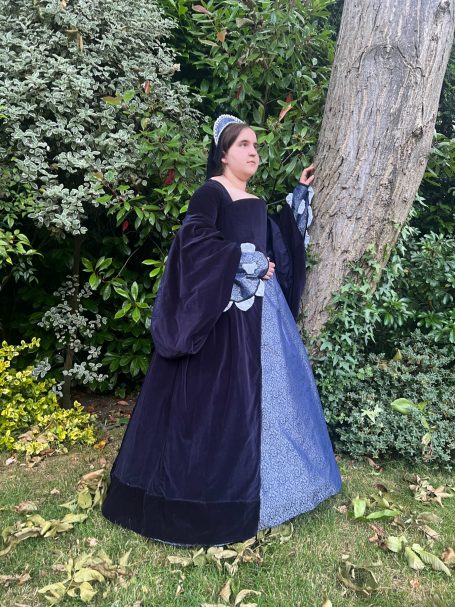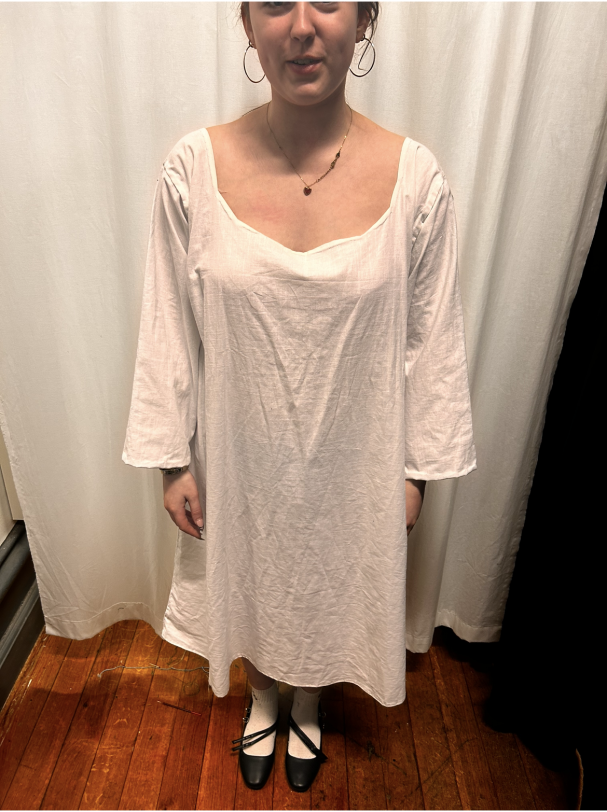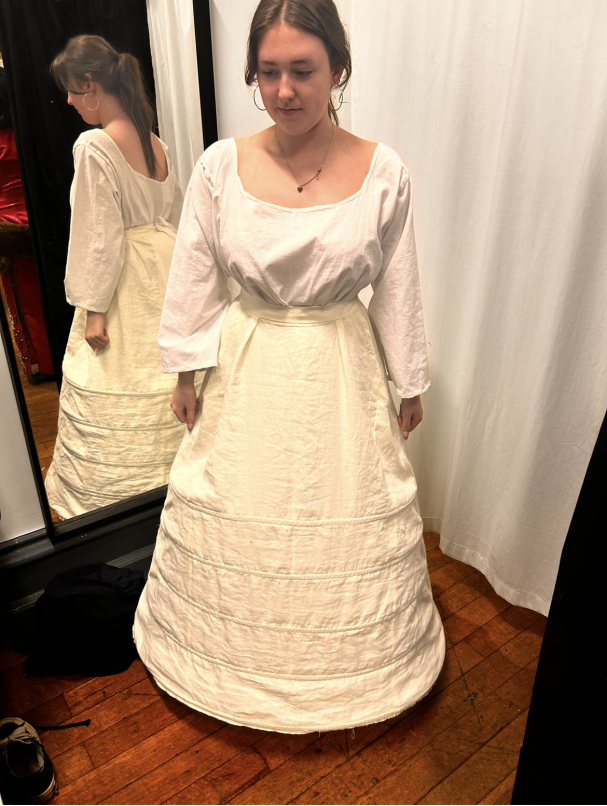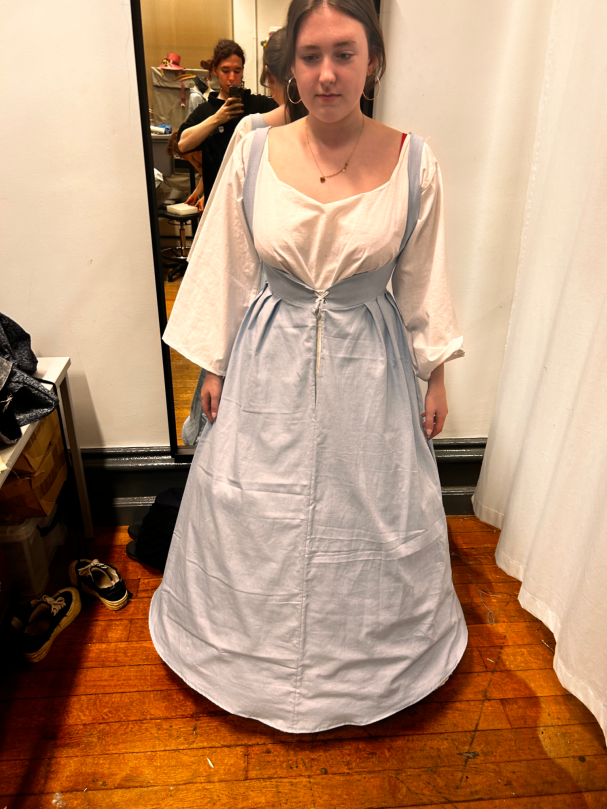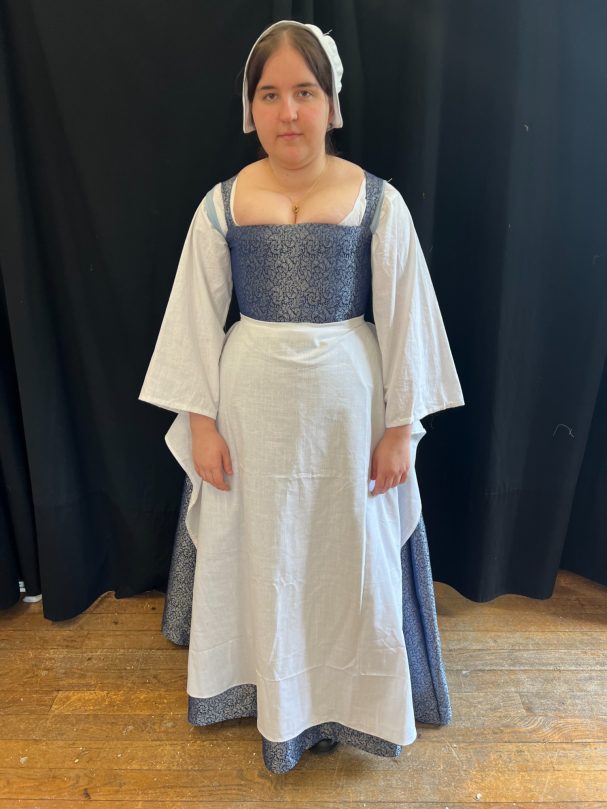Witchfall - NTU Element Two
(Personal Project - Year 3)
This project, running from February 2024 through to April of the same year, adapted Victoria Lamb's 2013 novel Witchfall from her Tudor Witch Trilogy into a period drama TV mini-series. The project focused on historically-accurate costume design and making, with the goal to create an ultra-realistic world for the audience to get lost in. I also wanted to stay as close the Lamb's vison for the characters and places in the novel.
Full Project Portfolio Links:
For a full understanding of the Research portion of this project, click here to see full supporting work
For a full understanding of the Design portion of this project, click here for full design work
For a full understanding of the construction portion of this project, click here to see full construction work
Witchfall - Plot Synopsis
Title: Witchfall
Author: Victoria Lamb
Series: The Tudor Witch Trilogy – book #2
Witchfall, the second book in the series, follows Meg Lytton as she struggles to balance her life as a witch, a lady-in-waiting to the disgraced Princess Elizabeth, and her betrothal to the Spanish priest Alejandro De Castillo.
Set in 1555 Meg serves the Princess Elizabeth at Hampton Court, a place full of dangers that makes Meg’s survival so much harder. When the inquisition come to question Elizabeth on her knowledge of the Queen’s astrologer, Meg barely escapes torture with her life.
The Lady Elizabeth dreams of her deceased mother, Anne Boleyn. She believes she had a message, and Elizabeth forces Meg to summon her spirit. When the spell goes awry, Meg not only summons the dead queen, but her vile shadow-husband King Henry VIII whose intentions to destroy Elizabeth and rule England again strike fear into Meg.
But it is not only the perils of court Meg must battle against. Plagued with visions of her age-old enemy Marcus Dent, Meg must choose whether to ignore what she has seen or prepare for what seems a losing battle. As Meg uncovers more of Dent’s history, she learns of a witch’s prophecy that Dent would die at the hands of a witch that could summon a dead king.
In the midst of all else, Meg must juggle her betrothal to Alejandro. Kept hidden from all, the pair steal moments alone together whenever possible. And although Meg finds herself falling in love with Alejandro more everyday, she cannot ignore the fact that the pair are so ill-matched as a priest and a witch. As Alejandro presses her for an answer to his offer of marriage, Meg must decide if she can let her life as a witch go to be Alejandro’s wife.
The novel explores themes of love, loyalty, and the challenges of navigating a world where magic is both a gift and a curse. With a blend of historical accuracy and elements of fantasy, Witchfall paints a vivid picture of a fascinating and perilous period in English history. The plot weaves together elements of romance, magic, and political drama against the backdrop of a turbulent historical period.
The Research
The research for this project started with separating the real historical figures used as characters from the fictitious ones that Lamb created for her story. After doing so, these figures could be properly researched to understand their affect on the time period and what was happening in their lives. For my project, the people researched were: The Spanish Inquisition (For Alejandro), Elizabeth Tudor, Henry VIII, Anne Boleyn, Mary I, and John Dee. Researching these people helped to influence how they would be designed later on.
From here, my research took me into looking at the 1550s as a whole, and better understanding the garments worn and fashions of the time. I must give credit to The Tudor Tailor and The Typical Tudor here, as they were wonderful resources for understanding silhouettes for people from all walks of Tudor life.
I also researched locations for filming my hypothetical TV drama. As Lamb sets her novel in real historical houses: Hampton Court, Hatfield House etc. I wanted to research to see if these would be ideal places to film, or if other locations would be better suited. On top of this, Lamb crafts some fictitious place, such as Dent's Tower and Meg's ancestral home. Research needed to be done into appropriate locations for these places, and places picked can be found opposite.
The Locations in the book are: Hampton Court, Hatfield House, Lytton Park, Dent's Tower
My full researching work can be seen by clicking the link under "Full Project Portfolio Links" above
Research - Moodboards
After finishing all research, I collated what I had into moodboards for each character I was designing for. With these moodboards, I focused on matching characters up to relevant paintings and portraiture of the time. Real historical figures were matched to their own portraits, while fictitious characters were matched to paintings depicting people of a similar social standing. Colour palettes were drawn from these portraits to remain as accurate to the time as possible.
(Click to enlarge images)
The Design Phase
Once I had collated all of my research into moodboards, I moved through into the design phase of this project. Designing with historical accuracy and portraiture in mind, the choices for my designs are as follows.
Bessie and Lucy: Designed in simple waistcoat style bodices with petticoat skirts, these costumes are identical to relay the idea they are siblings. Lucy's costumes is designed to be too large for her, as if they are her older sister Bessie's clothes that she no longer needs.
Elizabeth Tudor (Nightgown): A shift with embroidered hem and a wrap featuring the same embroidery. Rose embroidery was a motif seen on clothes throughout the Tudor period, as the rose was a part of the Tudor family crest. As a princess, Elizabeth would be able to afford embroidery on her shift. The rose was picked to show her claim to the throne as Henry VIII's heir.
Alejandro (Priest Costume): A hooded robe in black, similar to those found in portraiture of the Spanish Inquisition. As he is a novice, his robe is plain. He carries a red ornate rosary to show his birth heritage as a Spanish noble, the cross at the end of it being the cross used in the Spanish Inquisition crest. His plain silver crucifix at his neck is a significant part of the story later on, and Lamb describes him as always wearing it.
John Dee: Wearing a black cap and long open-sleeved gown trimmed with fur. The lining of his gown is patterned with alchemical circles for conjuring. Although not historically accurate, this design choice adds to his character as a magician and conjurer.
Anne Boleyn: Wearing a French gown and French Hood, this dress and headwear was taken from one of Anne's most iconic portraits. The costume also features the iconic "B" necklace - this is so the audience knows who she is straight away.
Meg Lytton: A blue velvet French gown and French Hood. Meg's costume is designed to be worn twice throughout the show. Firstly with the gown and hood (right) when she serves the princess Elizabeth at court. The second (right) is when she is dismissed from Elizabeth's serviced and forced to return home and run her father's house doing chores and overseeing servants. Recycling gowns in this way was a practice seen in Tudor times. This was the costume I made.
(Click to enlarge image)
The Construction Phase
(For a full method of make, see files linked at top of page)
The Patterns
To create Meg's costume, The Tudor Tailor by Ninya Mikhaila and Jane Malcolm-Davies were an invaluable source. I used their patterns to construct the majority of the garments in this in my costume. How I constructed these pieces varied from their instructions, as they suggest to make everything by hand.
The Costume
Opposite are photos of the costume pieces, as well some method photos to evidence how they were made.
Meg's Costume consists of ten pieces, these are as follows:
Shoes (sourced): Bought from Primark. Although not historically accurate, these are as close as I could get to original footwear without needing to make something.
Shift (made): Made from a linen look cotton. Original shifts were made from complete linen, but due to budgeting I was unable to buy linen. Linen look cotton works exactly the same to produce an authentic historical look.
Farthingale (made): Made from an unbleached canvas, the farthingale features 5mm hooping steel in twill tape boning channels to keep the shape. There is a small bum pad in the back, which is filled with polyfill. Although steel and polyfill are not historically accurate, using reeds or sticks to give the shape was not an option to me. Also, I needed to make sure the farthingale would support the heavy Jacquard and velvet layers
Petticoat (made): Made from a pale blue cotton, this is completely accurate to the time except from the machine hem, which was done due to time constraints.
Kirtle (made): A kirtle of blue Jacquard, lined with thick canvas and buckram in the front. The eyelets are metal to ensure longevity. All is made historically accurate apart from the machine hem which was done for time.
French Hood: French hood is made from a buckram and millinery wire base which was covered in domette to smooth the shape. The pieces were then covered in the jaquard and velvet to match the French Gown. The brim of the hood was decorated in pearl beads and silverwork embroidery stitches in my own design.
Gown: Made from a blue cotton velvet, the bodice is lined with a silk lining in grey. The bodice is also lined with a thick canvas and has buckram in the placard. The gown laces up at the front underneath the placard.
Foresleeves: Made from the blue Jacquard, with the puffs created from the linen-look cotton. Bound edges as historically done.
Henrician Coif: Made with the same linen-look cotton as the shift, a millinery wire frame is sewn in around the brim of the hat to keep it's shape
Apron: Made from same linen-look cotton. Made in the signature square style with the loose corners of the period.
We need your consent to load the translations
We use a third-party service to translate the website content that may collect data about your activity. Please review the details in the privacy policy and accept the service to view the translations.

